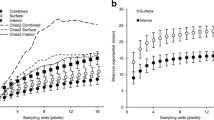Summary
Transects were cut from alder leaves incubated in a freshwater stream and plated as quadrats so that fungal isolates could be mapped by reconstruction of each transect. Initially there was fewer than one aquatic hyphomycete colonist per quadrat, but the mode increased to 6–7 then progressively decreased to <1. Numbers of species of aquatic hyphomycetes per quadrat rose and fell similarly with a maximum mode of 3–4, as did species per transect with a maximum of 11 and a diversity of 16, comprising 6 ‘dominant’ species and about 10 ‘occasional’ species. The latter showed no pattern of appearance but the dominant group was established early and persisted in a dynamic equilibrium. Aquatic hyphomycetes were initially randomly distributed but developed progressively into clumped consortia which persisted after peak colonization, declining as leaf degradation became total. Colonies of the most persistent aquatic hyphomycete species were initially discrete,developing into a complex network of overlapping colonies and species, no two of which showed positive association. These complexes broke down to large colonies of a few species and finally to 1–2 small colonies. The pattern of isolates of the 18 genera of other fungi was the reverse of that for aquatic hyphomycetes. Only Cladosporium, Epicoccum and Fusarium were important colonizers. The first two appear to be inhibited by aquatic hyphomycetes, but were found to degrade substrates representative of cell-wall polymers vigorously whereas aquatic hyphomycetes showed varied degradative ability. Leaf transects were examined by S.E.M. and epifluorescent microscopy so that hyphal colonization could be followed at progressive stages of leaf degradation. Bacteria on transects were patchily distributed, the temporal pattern indicating inhibition by aquatic hyphomycetes and colonization of senescent hyphae.
Similar content being viewed by others
References
Bärlocher F (1982a) On the ecology of Ingoldian fungi. Bioscience 32:581–586
Bärlocher F (1982b) Conidium production from leaves and needles in four streams. Can J Bot 60:1487–1494
Bärlocher F, Kendrick B (1974) Dynamics of the fungal population on leaves in a stream. J Ecol 62:761–791
Bärlocher F, Schweizer M (1983) Effects of leaf size and decay rate on colonization by aquatic hyphomycetes. Oikos 41:205–210
Chamier A-C, Dixon PA (1982a) Pectinases in leaf degradation by aquatic hyphomycetes: the field study. The colonization-pattern of aquatic hyphomycetes on leaf packs in a Surrey stream. Oecologia (Berl) 52:109–115
Chamier A-C, Dixon PA (1982b) Pectinases in leaf degradation by aquatic hyphomycetes: the enzymes and leaf maceration. J Gen Microbiol 128:2469–2483
Dickinson CH (1971) Cultural studies of leaf saprophytes. In: TF Preece, CH Dickinson (eds), Ecology of leaf surface microorganisms. Academic Press, London New York, pp 129–138
Dickinson CH (1976) Fungi on the aerial surfaces of higher plants. In: CH Dickinson, TF Preece (eds), Microbiology of aerial plant surfaces. Academic Press, New York London, pp 293–324
Eggins HOW, Pugh GJF (1962) Isolation of cellulose-decomposing fungi from the soil. Nature 193:94–95
Frankland JC (1966) Succession of fungi on decaying petioles of Pteridium aquilinum. J Ecol 54:41–63
Godfrey BES (1983) Growth of two terrestrial microfungi on submerged alder leaves. Trans Br Mycol Soc 81:418–421
Hankin L, Anagnostakis SL (1975) The use of solid media for detection of enzyme production by fungi. Mycologia 67: 597–607
Hankin L, Anagnostakis SL (1977) Solid media containing CMC to detect Cx activity of micro-organisms. J Gen Microbiol 98:109–115
Hudson HJ (1971) The development of the saprophytic fungal flora as leaves senesce and fall. In: TF Preece, CH Dickinson (eds), Ecology of leaf surface micro-organisms. Academic Press, London New York, pp 447–456
Levi MP, Merrill W, Cowling EB (1968) Role of nitrogen in wood deterioration. Phytopathology 58:626–634
Maguire B Jr (1963) Passive dispersal of small aquatic organisms and their colonization of small bodies of water. Ecol Monogr 33:161–185
McNaughton SJ (1981) Niche: Definition and generalizations. In: DT Wicklow, GC Carroll (eds), The Fungal Community. Marcel Dekker, New York, pp 79–88
Paton AM, Jones SM (1971) Techniques involving optical brightening agents. In: JR Norris, DW Ribbons (eds), Methods in microbiology, vol 5A, Academic Press, London New York, pp 135–144
Pugh GJF, Buckley NG (1971) The leaf surface as a substrate for colonization by fungi. In: TF Preece, CH Dickinson (eds), Ecology of leaf surface micro-organisms. Academic Press, London New York, pp 431–446
Shearer CA, Lane LC (1983) Comparison of three techniques for the study of aquatic hyphomycete communities. Mycologia 75:498–508
Singh N (1982) Cellulose decomposition by some tropical aquatic hyphomycetes. Trans Br Mycol Soc 79:560–561
States JS (1981) Useful criteria in the description of fungal communities. In: DT Wicklow, GC Carroll (eds), The Fungal Community. Marcel Dekker, New York, pp 185–199
Stott MA (1971) Studies on the physiology of some leaf saprophytes. In: TF Preece, CH Dickinson (eds). Ecology of leaf surface micro-organisms. Academic Press, London New York, pp 203–210
Wainwright M (1982) Origin of fungal colonies on dilution and soil plates determined using nonanoic acid. Trans Br Mycol Soc 79:178–179
Author information
Authors and Affiliations
Rights and permissions
About this article
Cite this article
Chamier, AC., Dixon, P.A. & Archer, S.A. The spatial distribution of fungi on decomposing alder leaves in a freshwater stream. Oecologia 64, 92–103 (1984). https://doi.org/10.1007/BF00377550
Received:
Issue Date:
DOI: https://doi.org/10.1007/BF00377550




